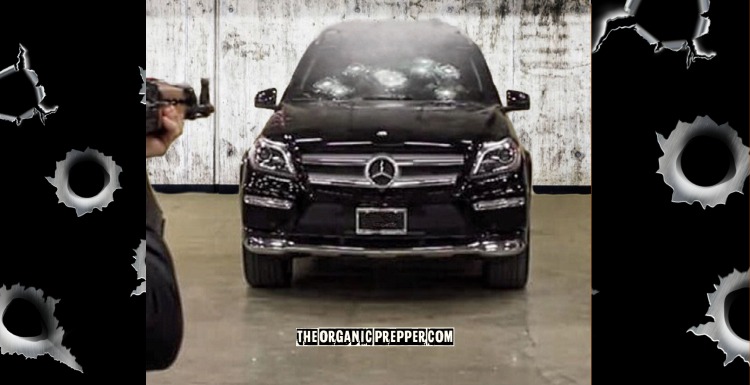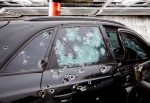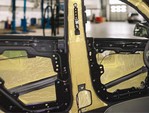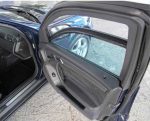If you're new here, you may want to subscribe to my RSS feed. Thanks for visiting!
High crime rates are a common form of SHTF. It affects everyone, but each segment of society responds differently. The poor fight it out and struggle to eke out survival. The rich spend their wealth on ostentatious security measures like guards and armored vehicles.
As mentioned in my last article about Thirdworldization, crime and violence are on the rise in major U.S. cities and almost everywhere.
Toby and Daisy asked me to expand on the topic, specifically armored vehicles, which are ubiquitous here where I live. Here is the lowdown.
Brazil has the largest fleet of armored vehicles for civilians in the world
It’s a damning record and apparent symptom of an utterly unequal, divided, and scared society. A violent one, too: Brazil leads the world in the number of firearm deaths (43,000), with U.S. coming second (37,000). It ranks fifth in firearm deaths per 100,000 inhabitants (23,9), while the U.S. is seventh with half of that (12,1).
But statistics alone don’t tell the whole story: behind the numbers lies one significant distinction.
Let’s consider firearms restrictions for civilians (i.e., only the bad guys and the police are armed here), and gun violence in Brazil is mostly from homicides (94%, whereas in the U.S., 64% are from suicide). It becomes evident how exceptionally lethal criminality and crime-fighting are around here.
Statistics may vary slightly according to sources and studies over the years. But I mention these differences, in particular, to illustrate how civil unrest and violence is something very characteristic of underdeveloped countries, in opposition to more developed ones. It is something visible in other social markers as well. For instance, public transit is also deadlier in Brazil compared to the U.S.
That explains in good part why private security in general and armored vehicles are big industries and thriving businesses here. Unsurprisingly, the authorities play dumb about this. Advertising such a dubious title would be an admission of incompetence and failure in dealing with public safety. But that’s what it is.
Spike in crime is the first and immediate result of any and every kind of SHTF
How some preppers overlook or dismiss crime waves as a real, present threat is beyond me. The bad guys are always lurking, and good people can do bad things in certain circumstances too. I can already see some saying crime is non-existent in their area. Others may say the offenders will be met with loads of weapons and determination to fight.
I put the final touches on this article as Daisy’s post on situational bias came out, addressing the subject comprehensively. These are common idealizations of people living in highly civilized places. I get that all the time, even from residents of “nice” neighborhoods here. Many believe crime is distant. They think they are safe by either owning (or hiring) guns or some other spurious reason.
I’m 100% with Daisy on that. I am in no way saying we should take it and do nothing. The world is inherently unsafe, and things change, fast or slow. There’s nothing wrong with being conscious, aware, and prepared. Thinking “this can’t/won’t happen” or “we’re safe” is the wrong mentality. If things are boiling (an economic downturn, social tension, and institutional disorder), it’s just a matter of time. Crime may hit urban centers first, but eventually, it rises and spreads.
No place is an island.
“Everything is interconnected” is an excellent principle by which to live.
We’ve been living in prosperous, relatively calm, and civilized times for the past two or three decades. Sure, famine, misery, disasters, and conflicts haven’t been eradicated. But there’s been a long enough period of progress and stability to lure people into thinking things can’t go back or become fluid again.
Then something like 9/11 or COVID19 strikes, and suddenly we’re reminded: things can and do change.
But this article is not about full-SHTF. Big disasters aren’t always necessary for decay to take place in society or community. Once things turn bad and the effects of some collapse start spreading, the social fabric wears thin. It usually happens faster than most believe because building takes time, but destroying is quick.
Here’s some context for a better understanding of armored vehicles
Developing countries are nothing like many in the first-world think. The differences for the average population are more subtle than imagined by most folks from either.
Someone visiting Buenos Aires (Argentina’s capital) or São Paulo (the biggest city in Brazil) would feel a lot like N.Y., LA, or other large metros of Europe: vibrant streets and avenues, hectic commerce, theaters, museums, and parks. Tall buildings, fancy cars, and condos. You can eat (very) well and enjoy the nightlife, or attend the same shows and live concerts everywhere else in the world (not now, but you get the point). Things may not be as tidy as in London or Zurich, but it’s perfectly possible to walk around and visit extraordinary places normally and safely.
Many developing countries are affluent. In many ways, Brazil is incredibly wealthy: we’re 212 million living in a free, democratic, urbanized, industrialized, continental-sized land blessed by resources and diverse environment, and no grave natural disasters of any kind. Also, no wars, mass shootings, or terrorism.
Our major disasters are all human-made: corruption, bureaucracy, and debilitating inefficiencies prevent much of this natural wealth from being efficiently harnessed, transformed, and fairly distributed for the good of the people and progress of the collective, causing significant social inequalities. In various degrees, it’s the same in most other developing countries. Some are doing better (democracies), others worse (dictatorships).
The real SHTF in most third-world countries is the profoundly unequal distribution of wealth
Said differently, there’s a lot of money circulating. But it’s in the hands of few, so there’s also a lot of poverty. Poor education and low productivity render ill effects on the population. Violence and crime are the perverse byproducts of this gap because, in such unbalanced societies, everyone is fending for themselves. It’s a lot more surviving and a little less living, on all levels, and for everyone.
The rich “survive” by investing in measures to keep their lifestyle and warrant safety for them and their families. These “bubbles” are made possible by the multi-billion private security business, an industry employing millions and shaping the landscape from costumes to architecture. If there’s demand, there’s an offer.
The widespread use of armored civilian vehicles is part of that. Something that some see as an extreme personal safety measure or an extravagance in most other countries (even ones in war) is quite ubiquitous in the streets of every big city here.
Crime and violence are not the same everywhere
All that may sound like life is all hell in a developing country, but it’s not. It is far from that. Inequality means contrast, and that’s precisely what makes things crazy. Most places are safe and normal, and every day is pretty standard. But the dangerous areas are very, very dangerous and violent. Most “favelas” and the suburbs where public services are deficient are one example.
As I said, crime spreads if the context is favorable. When crime finds its way into safer areas (as it always does), this gives a generalized feeling of insecurity. That’s why a single case can instantly scare people and instill fear and insecurity in a zero-crime area or town.
If I had to use one word to describe it, I’d say it’s like a lottery: whatever the odds, knowing you can get robbed or shot is a load, a burden. This feeling is like a fog that never lifts completely, and it’s difficult to lower your guard completely. Everyone takes their measures and moves on with life. When we add that people spend a lot of time driving (also because public transportation is deficient), the search for armored vehicles is a logical conclusion.
Driving around in fancy armored vehicles is a status symbol
Not as much today as in years past, but another crazy distortion all the same. In a dysfunctional society stricken by violent crime, flaunting a “blindado” (especially a luxury one) remains a way of showing you belong to the top 1%. Sure enough, adding $10-20K of ballistic protection on top of an already expensive car is not for many.
It’s a dubious distinction, though a form of imprisonment and a way to draw unwanted attention. It also implies high maintenance costs and demands lifestyle adaptations to go from A to B, usually stuck in traffic for hours. I have friends and relatives driving armored cars, trucks, and SUVs. I understand the rationale but can’t avoid seeing the other side.
How does the industry of armored vehicles work?
As happens with gun licensing around here, the Army and the Feds control vehicle armoring. They issue the licenses and regulations according to specific guidelines. When it comes to market, it’s possible to buy any car (new or used) from a regular dealer and have it adapted aftermarket. Or purchase new and armored OEM from the manufacturer. Or buy second-hand. Some shops purchase new vehicles from various brands, make the adaptations, and sell under their brand.
The different levels of ballistic protection in armored vehicles:
- Level 1 and 2 is “lightweight” armoring: reinforced glass and some Kevlar panels to offer protection against small caliber pistols and breakage. These can be bought without bureaucracy.
- Level 3-A is the most common and seen everywhere: 90% of armored civil vehicles are in this category. It requires background and criminal check for a special license to add heavy, 1″ (or more) multilayer laminated glass, run-flat tires, heavier ballistic shielding – which can add up to 100kg or 220lb. Or more in rolling weight to the car/SUV.
- Then there’s Level 3: with even more reinforcements to protect against rifles such as A.R.s and A.K.s. This level isn’t allowed for civilians in general unless there’s some justification (like a death threat or something), which is rare because there’s no terrorism, or many big-caliber rifles going around, just “regular” criminality (the irony).
- Finally, there’s Levels 4 and 5: It’s something like “The Beast” (the U.S. presidential vehicle). Not quite like The Cadillac One, but these offer heavy-artillery protection (against RPGs, grenades, .50cal, etc.) and unique cabin survival systems. Those are exclusively for particular uses (diplomats, military, government figures, some police units, etc.).
Vehicle armoring is a specialized service only provided by specialized companies
There are no homemade adaptations because it demands specialized labor, equipment, and materials. Armoring shops also need a license. Many are from U.S., Israel, or another country. Since these armored vehicles can be used to commit crimes or protect criminals, the authorities keep tight control over the industry, the cars, and the material used.
Besides, cars are valuable, expensive assets – especially armored – so people don’t want to lose (much) money doing half-assed jobs on their fancy trucks and SUVs. Most importantly, the protection must be warrantied to work because no one knows where the bullet may hit. Thus the whole process has strict quality control for liability, warranty, and insurance reasons.
Some types of cars are preferred
According to their standards, some makers (usually high-end euros like BMW, Audi, Land Rover, Volvo, etc.) have their own armoring contractors to warrant performance and coverage. Luxury (Bentley, etc.) and family SUVs (such as Porsche Cayenne and Range Rover Sport) get armored frequently. More popular brands like Honda, Mitsubishi, V.W., etc., also offer OEM armoring as optional on some models. Sports cars (Porsche, Lamborghini, Ferrari, Aston Martin, etc.) are rarely adapted because they’re too expensive, and armoring a car completely f***s it up. Thus owners prefer to leave these in their original state.
Armored vehicles are very different from an original one to drive and maintain
Due to the extra weight and special disassembling/reassembling needed, the car suffers a lot more wear and tear than a regular vehicle and needs reinforcements and special parts. Maintenance is also costly because it demands specialized disassembling/reassembling of the armoring to switch a lamp or repair a body part or even change a tire. More powerful ones are preferred to carry all that extra load without losing (much) agility. The weight also changes the vehicle’s center of gravity, which alters behavior and thus driving.
Who drives armored vehicles?
Rich people from all walks of life: CEOs, artists, high-profile sports figures, etc. Many companies provide armored vehicles to their higher executives and sometimes even to their families as part of the package. The government also provides armored cars to some politicians, ministers, judges, etc., and some police units have a number of them.
Second-hand (used) market is also huge. Since armoring adds a lot of cost to already expensive cars, many opt for used ones for relatives (like the son’s/daughter’s first car) or employees. Companies and shops dealing with gold, jewelry, cash payments, etc., also employ used ones for transportation and deliveries.
The market for armored vehicles continues to grow
As deaths from firearms increased in Brazil from 25,819 in 1990 to 48,493 in 2017, the government is incapable of providing safety. The population remains unarmed while the bad guys have lots of firearms. Those disparities reflect an increase in polarization and furthering of social division.
As the economy plummets, with the rich keep getting richer and the poorer becoming poorer, these trends show no sign of reverting. If anything, it should get worse. That spells good winds for the private security sector going ahead.
And unfortunately, a continuing SHTF of criminality and violence for the rest, especially the ones who can’t afford to isolate themselves and their families behind a moving shield of aramid and reinforced glass to move around.
About Fabian
Fabian Ommar is a 50-year-old middle-class worker living in São Paulo, Brazil. Far from being the super-tactical or highly trained military survivor type, he is the average joe who since his youth has been involved with self-reliance and outdoor activities and the practical side of balancing life between a big city and rural/wilderness settings. Since the 2008 world economic crisis, he has been training and helping others in his area to become better prepared for the “constant, slow-burning SHTF” of living in a 3rd world country.
Fabian’s ebook, Street Survivalism: A Practical Training Guide To Life In The City, is a practical training method for common city dwellers based on the lifestyle of the homeless (real-life survivors) to be more psychologically, mentally, and physically prepared to deal with the harsh reality of the streets during normal or difficult times.
You can follow Fabian on Instagram @stoicsurvivor





















“an admission of incompetence and failure in dealing with public safety”
a violent society is not the fault of the police.
civilized people get police. hostiles get troops. animals get zookeepers.
@ant7 I didn’t mean it’s the police’s fault, police’s not even at the top of the chain of command, they suffer from this too. It’s on a whole the failure of society. everything is connected, very difficult to cast the blame of something like this onto one or another part only. Even the people is to blame.
“’Everything is interconnected’ is an excellent principle by which to live”
sure. but lots of preppers/survivalists just don’t get that. they’re in their own little world, which for them is The World, and they experience Other People as an irrational illegitimate (even evil) intrusion on Their World to be avoided or eliminated. so they’re attracted to libertarianism, hoping to reduce human interactions to black box economic processes. and they hate government (they don’t, they’re quite willing to exercise all of government’s powers in and of and by themselves, what they really hate is Other People being any kind of government at all) because they can’t avoid or eliminate it (yet). and they retreat into the wilderness (after accumulating a pile of society’s manufactured goods) saying they’re independent and don’t need anyone. and they accumulate 10,000 cartridges of ammo and talk about “one shot one kill”.
“fairly distributed”
what does “fairly distributed” look like?
It’s impossible to have “perfect distribution”, because humans are imperfect and this everything we create will be imperfect. But more fairly distributed means exactly smaller social gaps, as found in developed nations.
In every system there will be outliars, the average and bellow average. But a more civilized society does a better job distributing the innate wealth of natural resources and the wealth produced instead of concentrating 80% in the hand of 1% and leaving the crumbs for the rest. A smart society does that for it’s own better living BTW.
“more fairly distributed means exactly smaller social gaps”
well what we observe in societies that attempt deliberate “fair distribution” and “smaller social gaps” is equal poverty all around. except for the ruling class of course, they wind up wealthier than any industrial magnate, because in practice they own and control everything including the people.
Not really, I’m talking about exactly free market, liberty and a strong collective here, not socialism/communism or any other sort of centralized regime which I know all too well has never worked before in history.
When this is achieved by freedom, hard work and merit rather than imposition or other artificial means, you have a fairer, more civilized and advanced society. It’s the only way IMHO.
Maybe go home to Turkey Bro, or wherever TF you from. Your comments are BS and Ms. Daisy and her authors are here to EDUCATE. You got alot of “I know better” and not a lot of “let me share”. No Mr. Rogers in your neiborhood, bro? TAF you think you got with your quotes, and your quirky peeves. Maybe “ant” serves you, cause unlike MCU, you tiny AF. Drop those life stories, or back TF up off Fabian.
“Your comments are BS”
you mean I don’t fit in with the club. you’re right, I don’t. and that has its good points, and its bad.
if daisy asks me to stop posting, I’ll stop.
This is a good educational article. I’ve got a little experience in this.
There will be significant differences if and only if The People keep what they have. There is a huge push for them to give that up currently.
Private ownership in the middle class of armor and weapons is much higher than many other countries.
Up armor vehicles can get complex especially when people try and use soft steel. The weight crushes mileage, maneuverability and vision.
So where does that leave the rest of us? The same place we always are between politicians, criminals and elite. Right smack in the middle.
“Private ownership in the middle class of armor and weapons is much higher than many other countries.”
That was my thought when I read Fabian’s article. Lots of guns and plate carriers, but I don’t know anyone with an armored vehicle!
“I don’t know anyone with an armored vehicle”
most preppers anticipated “THE END OF THE WORLD!” where there’s little fuel at any price, not for venezuela/brazil where resources are abundant if you have enough money and/or political connections. but it looks like we’re heading for venezuela/brazil instead. maybe everyone needs to reconsider.
remember all those semi-armored and armed vehicles in mad max? could start there.
@ant7
I guess we in Brazil could be headed for Venezuela. U.S. could be headed for Brazil.
But I don’t think so, not on both cases. Talking from my ignorance here, I know U.S. and I’m aware of the differences but anyway this is complex to discuss and hard (impossible) to forecast. Both U.S. and Brazil would fight before something like this happens… but then we’re already seeing much fighting against all the crap that’s been thrown at us since 2020 so it could well end up there before people realize indeed.
I can see things getting a lot worse in many aspects in the next 5, 10 or even 15 years, depending on how this whole thing unfolds. It may end up OK, it may be a Roaring 20’s revival until something happens, it could go bad then recover. Who knows.
Either way, I can’t see an easy or pain-free exit to this mess. There’s just no will to compromise and fix and get together. And there’s this pandemic. Divisiveness and social/economical gaps are just too wide and there’s not an easy fix for this, it’s just how things are.
There’s a price to be paid no matter what. I’m not preparing for a Mad Max SHTF (not ruling it out either), but we’re moving fast towards a slow burning one, just a matter of how bad and long it will be. Just prepare for bad and difficult times going ahead.
@Matt in OK, precisely, in all points and on all accounts.
Excellent food for thought Fabian. My DW went to Argentina a few years back on business and witnessed the same class division as you mentioned in Brazil . One side of town the people drove high end cars and the other side folks lived in burn out homes with no roofs. Almost all of the small shops/businesses were bankrupt/closed but the big box stores open. Yup, they have Walmart’s in Argentina, but almost no Middle Class.
Thanks @Seminole Wind.
Argentina has been suffering with serious political and economical issues for decades. I’m sad, it is also a beautiful country with a lot of wealth and wonderful natural resources, and in fact a very well educated and civilized population.
It once was a truly developed, rich and highly civilized nation, almost like a latin Switzerland really, they have everything going for them.
But unfortunately they also face the same human-made SHTF I talked about in my post, which sooner or later ends up destroying the social contract and all the rest goes with it.
My point is exactly that, I’m not predicting anything just saying that this is what happens when the economy goes bad for too long, there’s too much wealth concentration and too many suffering in despair.
Armored cars attract unwanted attention!
So are they really safer? No they are not, at least not for the average person.
Now if you are a dignitary or something like that, then maybe. It depends upon the threat level.
Explosives can still destroy most armored cars. If you use enough.
So it all boils down to the threat level you face and how noticeable your lifestyle is.
@Mic, I think they draw unwanted attention too. But try to think in the context of a society so used to them, for so long, that they become commonplace and no one really pays much attention anymore. It’s just everyday for the most part.
But for everyday crime such as break-ins, car jacks, hijacks, robberies, etc. they do provide safety. It’s heavyweight stuff, enough to stop 9mm or even 45cal. multiple hits. Shotguns and rifles aren’t too common, much less explosives, but Level 3A armoring can help some with that too, maybe enough to get you alive at the end.
It’s almost inviolable. I get it that life is more valuable than money and this is the thinking behind someone who opts for an armored car for themselves or their families. These folks already live in big houses and fancy condos and travels only the safest places in town. it’s the same everywhere.
Some people here get robbed still, because they forget to lock the doors, or drive with windows open, or when they’re entering/leaving their vehicles. There’s a “how-to” in many aspects when it comes to these things. Pretty crazy.
So im living in fear for my life, and I am a body guard for rich putz #1, his wife #2 and their spoiled rotten kid(s) Maybe there are a few of us guarding this ‘important’ person. If it’s truly going down, it won’t be hard at all for me to pop him, his ball and chain, and those worthless kids and live in the big house myself. Move my family in, along with the other guys who were paid to ‘protect’ mr richy rich. Will the cops really care as long as they are still getting their kickbacks? Chances are the cops are home protecting their families and not really on the job too, if it’s gotten that bad.
Oh by the way, I have this nice safe car to drive around in now too although that IMO is a huge sign saying hey I got STUFF!!! Come get it!!!
A A Ron
@A A Ron, you hit the nail on this. It’s something I’ve been talking about (the interconnectedness of everything and unforeseen developments).
It’s about people, the system is the people running it. And people are not robots. They think, they have needs, they can be good or evil, they live in different places and contexts, and they react to changes in different manners. People are unpredictable.
Some folks just think in terms of normal life. It’s normal now, so they pay for safety by hiring guns, alarms, armored cars, bodyguards, chauffeurs, private investigators, everything. But there’s institutional order backing all that. There’s police, justice, press.
Good or bad, efficient or not much, there’s a working system. If something happens, there are consequences. All this can change and people would change too. Selco is always touching on that and I feel it’s hard to get the message across to people who have never come into contact with these realities, because it’s something new and to may it’s unimaginable. But it’s real.
This you mentioned does happen. Not like that, because things are normal and there’s law. What happens is, some of these people working for millionaires and billionaires (in all areas not only security but also housekeeping, nursing, banking, landscaping, whatever) know a lot. Information can be an asset, it’s always worth something for someone who can make a profit on it or use for something.
And on occasion they sell/give this information in exchange for money, drug, criminal debt payment or whatever (sometimes they talk just not to be killed). It’s something that allows the real criminals to make plans and attack. In the 80’s a lot of high profile people got robbed or hijacked for ransom this way here, in Mexico, Chile and many others. It’s more common than people think.
This is another aspect of social division: resentment, anger, despair. Poor against rich, suburbanites against downtowners, everyone turns agains everyone. Economical and social collapse may not lead some to commit crime or violence, but they can lead or make it easier for others to do so. It’s still common for insiders to give or sell information because low-wage people live in places where everyone knows a criminal or gang member, or a group willing to plan a job. You can’t just hire anyone to work for you and think it’s going to be OK forever. This is what I talk about slow burning societal SHTF.
The really really wealthy (bankers, billionaires, etc) already pay for police and even federal protection. They have the whole public security system providing them privileged and advanced information about the underground: schemes, plans and potential threats leaking from the “criminal grapevine”.
They have private and public security, this cost millions per year for them, their families and also their companies, but they can afford. These would hire mercenaries in a SHTF because as I said in my previous post, money can buy a lot even in a conflicted world. Even an insider as you mention would have a hard time disrupting that because there’s a lot of money flowing and money can buy everything.
But the rest would have a hard time even realizing that insiders who work all around them – from guards to trash collectors and everyone else, even the ones serving their tables or mowing their law or teaching their kids, etc. (you get my point) may in fact turn agains them, or even just abandoning them.
I guess that all depends on the context. And this is what I was trying to convey in my other post: depending on how bad things get, law enforcement and just general civil, social and institutional order can lead to developments many people have no idea or aren’t even considering, but that already take place in some not as civilized places like here.
Don’t they get top-heavy, and more of a rollover risk and then you corner too fast and you’re inverted and you can’t open the window anymore because it’s bulletproof and now it’s on fire and don’t YOU feel stupid, trapped n your deathtank car…thing…Brazil apparently has more assholes per capita than the US even though the US gets all the bad press for gun deaths…
You should do some research and check these new modern armored cars out. They are fast, can corner and have a lot of unexpected features.
https://youtu.be/Hh0v6kx4jcg